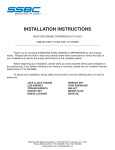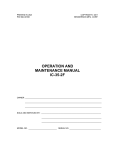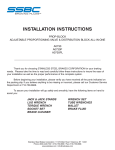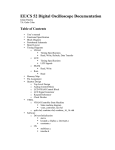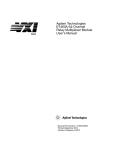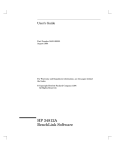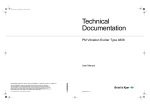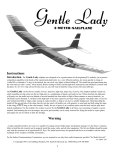Download Instructions - Summit Racing
Transcript
INSTALLATION INSTRUCTIONS REAR DISC BRAKE CONVERSION KIT SUM-BK1333 1978-88 GM G-BODY _____________________________________________________________________ Thank you for choosing SUMMIT RACING for your braking needs. Pleases take the time to read and carefully follow these instructions to insure the ease of your installation as well as the proper performance of the complete system. Before beginning your installation, please verify you have received all the parts indicated on the packing slip. If you believe anything to be missing or incorrect, please call our Customer Service Department at 330-630-0240. To assure your installation will go safely and smoothly, have the following items on hand to assist you: JACK & JACK STANDS LUG WRENCH TORQUE WRENCH SOCKET SET BRAKE CLEANER WRENCH SET MALLET TUBE WRENCHES BRAKE FLUID GEAR OIL CAUTION: BE CAREFUL THAT ALL HYDRAULIC COMPONENTS ARE KEPT CLEAN AND FREE OF DEBRIS INSIDE AND OUT. REMEMBER: DIRT IS THE ENEMY OF HYDRAULIC SYSTEMS. SSBC WILL NOT BE RESPONSIBLE FOR SYSTEM FAILURES DUE TO AN UNCLEAN INSTALLATION! 1) Raise the vehicle until the wheels and tires clear the floor. Support rear of vehicle on jack stands. Make sure parking brake is in the off position. Remove rear wheels and tire assemblies. 2) Remove drum assembly as follows: a) Remove brake drums. b) Disconnect parking brake cable from drum assembly. c) Disconnect rigid brake line at axle junction block. NOTE: We strongly recommend the use of a tube wrench. BE CAREFUL NOT TO GET BRAKE FLUID ON THE PAINT, IT CAN CAUSE SEVERE DAMAGE!! 3) Removing axles and backing plates a) Remove differential cover, a drain pan will be necessary. b) Working through the the opening of the case, remove the side gear pinion shaft lock bolt. (figure 1, B) c) Push the side gear pinion shaft (pin) out (figure 1, A) d) Push the axle shafts inward and remove "C" locks from inner end of the axle shafts. (figure 2) e) Remove axle shafts. (figure 3) f) Remove backing plate and shoes from axle flange as an assembly, after removing anchor bolt and lower cap screws; discard bolts and nuts. (figure 4) 4) Caliper Mounting Brackets (left and right side are different) a) Attach tie bracket to outboard side of axle flange using two (2) 1/4-28 socket head (allen) screws and lock washers. Mount with radial cut-out facing up. b) Install caliper mounting bracket from inboard side of axle housing flange making sure that spacer/thrust plug (pressed into bracket) enters large hole in axle flange bracket from inboard with caliper mounting holes at the rear. NOTE: Place two (2) 5/8" i.d. spacers between the caliper mounting bracket and flange and four (4) 7 /16" i.d. (2 per bolt) spacers between the tie bracket and the caliper mounting bracket to locate the caliper mounting bracket. c) d) 5) Secure bracket to flange using special 5/8"dia x 2" cap screw, lock washer and nut (inboard) and two (2) 7/16" dia. cap screws at the bottom which thread into tie bracket. Note figure 5 for right side arrangement of parts. Shock Mounts a) Remove lower shock absorber connection and shock mount stud (nut and lock washer must be removed first). INST22 SUM-BK1333 Revision 1 1 b) c) Install offset shock mount block and secure to original location with special 10mm loctite bolt and flat washer. Install original shock stud into offset block, install lower end of shock on stud and secure with original washer and nut. Torque to 35-45 ft-lbs. 6) Re-install Axles a) Slide axle shafts back into housing and follow step 3 in reverse. b) Fill differential with Hypoid gear lubricant 7) Mounting Calipers and rotors a) Mount rotors onto axle flanges, temporarily secure with lug nuts to assure retention (flat side of nuts toward rotor) b) Place caliper assembly over rotor (bleeder valve on top) and bolt to mounting bracket with bolts supplied. Torque bolts to 50 ft-lbs. (figure 6) 8) Parking brake cables a) Route parking brake cables under axle, (slide cable coil spring so that cable itself does not ride on axle). b) Advance caliper pistons, by working parking brake levers, until clearance between pads and rotor is approximately .008"-.010". (use a feeler gage) c) Adjust parking brake cable at equalizer by tightening nut until parking brake levers just begin to leave stops on caliper in released pedal position. 9) Brake Line and Bracket a) Screw tube nut of steel line into brass "banjo" block and torque to 20-30 ft-lbs. b) Attach brass "banjo" fitting with special hollow bolt and two copper washers (one top/one bottom) to caliper. Torque to 30-40 ft-lbs. c) Connect flex lines (from kit) between rigid caliper lines, (installed above) and original axle junction block. Before tightening fittings, make sure that the flex hoses are not twisted. Secure lines to axle housing by opening original line clip and closing gently. 10) Proportioning Valve (optional) a) The factory installed fixed proportioning valve is screwed directly into the rear port of the master cylinder. Our road tests indicate that it is not necessary to remove or disable this valve. However, should the user feel that front to rear brake biasing is required under some service conditions, an adjustable valve (optional at extra cost) is available from Summit Racing. b) If a valve is used, install in the brake line from the master cylinder serving the rear system, in place of the fixed valve. The "OUT" port goes to the rear brake side. c) When bleeding the system adjust the valve by turning the knob clockwise until it stops. DO NOT OVER TIGHTEN, THIS COULD DAMAGE THE VALVE. INST22 SUM-BK1333 Revision 1 2 11) Filling and Bleeding System a) We advise completely replacing the brake fluid if color is brown or muddy. This condition is due to water that has been absorbed by the fluid which will eventually corrode the brake lines and master cylinder, plus possibly creating a vapor lock under extreme braking conditions. Flush system system with clean brake fluid and replace with a good grade of disc brake fluid (DOT 3 or 4 Glycol base). b) If pressure bleeding is employed the correct pressure setting for the "bleeder ball" is 10-15 psi. (max.) c) If power brakes are fitted, the engine should not be running and the vacuum reserve should be reduced to zero by pumping the brake pedal or "pulling" the booster vacuum check valve. d) Tapping the caliper with a rawhide mallet as fluid is flowing out may assist in obtaining a better bleed job. e) Brake bleeding can be simplified and can serve to check that there are no line restrictions, by using the gravity bleed approach as follows : 1) Leave all bleeder screws open when installing calipers. 2) Fill master cylinder reservoir, do not pressurize system or pump brake pedal; instead observe bleeder ports until brake fluid flows out; then shut off bleeder valves. 3) No further procedure is required if brake pedal is hard after shutting off all bleeder valves. Make sure that the master cylinder is "topped-off." f) With bleeders closed and system bled, a hard pedal should be experienced so that at full application and with the engine running, the toe of your left foot can still be placed between the bottom of the pedal and the floor. 1) In addition there should be brake pedal end-play of 3/4 to 1" inch (from full release until initial braking action takes place). 2) Power brake units will experience a "drop-off" of the pedal when the engine is started. This is a normal condition and signifies that the booster is working correctly. DO NOT DRIVE THE VEHICLE UNTIL THE BRAKES WORK SAFELY, INITIAL BRAKING TESTS SHOULD BE DONE IN A SAFE OPEN AREA!! 12) Final Inspection a) Check for fluid leaks at every junction while an assistant is applying maximum brake pressure. 13) Final a) b) c) d) Assembly Mount wheel, torque lug nuts to proper specifications. Spin wheel to assure that there are no interferences. Test drive and apply brakes firmly several times to wear in pads, this is called burnishing the pads. Test parking brakes after pads have been burnished, adjust cables, if necessary. INST22 SUM-BK1333 Revision 1 3 DO NOT DRIVE IN TRAFFIC UNTIL THE BRAKES SAFELY STOP THE CAR A SAFE DISTANCE WITHOUT A SPONGY PEDAL FEEL! BRAKING TESTS SHOULD ALWAYS BE DONE IN A SAFE OPEN AREA! TECH LINE -- If technical help is required, please call 330-630-0240. NOW ENJOY ULTIMATE STOPPING POWER!!! INST22 SUM-BK1333 Revision 1 4 INST22 SUM-BK1333 Revision 1 5 Solutions Guide to commonly asked questions. Why is my brake pedal soft? How do you bench bleed a Master Cylinder? 1) In most cases, Air is trapped in the lines or calipers. Try re-bleeding the system. Do not force new fluid into new brake lines. It may foam and be very difficult to bleed. Make sure that the bleeder screws on the calipers are facing upward! Secure one of the ears in a vise so that you can take a large screwdriver and push the piston in. Fill the reservoir with clean fluid. Take a dummy line or our M/C bleeding kit and hook it up to the two ports. Front line to front and rear line to rear reservoirs. Slowly stroke the master and let it return slowly. You should see many air bubbles in the fluid. Repeat this step until you do not see any more air bubbles. Summit recommends ten (10) slow pumping strokes after you see no more air bubbles. This will insure a good hard pedal. (See Summit master cylinder bleeder kit instruction Sheet) 2) If all the air is out of the system, the pushrod from the booster may need adjustment, under the dash, to make it longer. Do not extend it too long or it will not allow the fluid to return, causing brakes to drag. Your pushrod may not be adjustable. If the pushrod can be made longer, try ¼ turn adjustments at a time. Summit stocks adjustable pushrods for many vehicles. In addition, the pushrod between the Booster and the Master Cylinder may need adjustment. Not all Booster to Master pushrods are adjustable. What is the best pad for my vehicle? Your choice of pads should be determined by how and where you drive the vehicle. If you drive in heavy stop and go traffic you would need a different pad than someone who is road racing. Contact Summit for the correct application. 3) You may have a bad Master Cylinder. Before you determine this, you should make sure that all the air is out of the system. When installing a new Master Cylinder, always bench bleed first. If you did not, take off the Master Cylinder and bench bleed it. (See Bench Bleeding Instructions below) How often should brake fluid be changed? (street application only, not racing) Why does the car pull to one side? The side that the car is pulling to is the caliper that is working. Re-bleed the opposite side and try carefully stopping again. When brake fluid turns brown, it is time to change the fluid. The brown color indicates that the fluid has absorbed water and dirt. D.O.T. #3 & #4 fluids absorb water. Silicone brake fluid is not for track racing. Why does it feel like there is no Power Assist? How can I tell which reservoir is the front or rear of the Master Cylinder? The Booster may not be getting enough vacuum to operate. On some high lift cams, the engine does not develop enough vacuum. The Booster needs at least 16” of vacuum to operate correctly at idle. If you do not have at least 16 inches of vacuum at idle, you may have to add a vacuum pump to your system. Check for vacuum leaks. There may be leaks in the intake manifold or hoses that would cause low vacuum. The Booster may be bad. Do a vacuum test. If the Booster can retain a vacuum for three (3) minutes after the vehicle is shut off, it is not a bad Booster (refer to steps 1 & 2). All Master Cylinders must be bench bled in a vise before being installed on the vehicle. The front reservoir is usually larger than the rear. In some cases, they are the same size. As a rule, for GM cars & trucks, the rear reservoir is for the rear brakes. On Ford cars & trucks, the front reservoir is for the rear brakes. On front wheel drive vehicles, the brakes are split diagonally. Each bowl of the master cylinder services one front wheel and one rear wheel. This will be important if you are installing a distribution block, proportioning valve, or residual valve. Hint: The larger bowl will feed the disc brakes. 1 Where is the best place to install a proportioning valve? How much brake pressure does it take to stop my vehicle? The best place to install a proportioning valve is after the distribution block. Do Not install it between the Distribution Bock and the Master Cylinder. You will not be able to get a hard pedal. Anywhere after the Distribution Block and before the rear flex hose is acceptable for installation. Most vehicles, power or non power brake, develop 1,200 P.S.I. When you panic stop or jump on the brakes hard, a surge of 1,400 P.S.I. can be achieved. If a factory proportioning valve installed on the vehicle, the rear brakes are only developing 600 – 700 P.S.I. Drum brakes require lower pressure because they grab more quickly. When rear disc brakes are installed, the rear brake pressure may be increased to 800 – 1,000 P.S.I. or more. A good way to check the pressures and to see if the system is working correctly, use a pressure gauge screwed into the bleeder port. A vehicle with less than 600 P.S.I. will not stop! Why should the flex hoses be replaced? They look O.K. from the outside. Flex hoses should be replaced every time the calipers are serviced. They flex up and down, just like a shock absorber. They are also under high pressure internally. Flex hoses have a rubber liner that will collapse over time. If it does collapse, it will act as a check valve and not allow fluid to return to the Master Cylinder. How tight should the wheel bearings be? The front bearings should always be torqued. Not just hand tightened. Bearings usually require 12-15 Ft./Lbs. of torque. Then you will probably need to back off a little to align the cotter pin hole. Do Not over tighten; the bearing life will be shortened. This procedure only applies to rear wheel drive vehicles with separate bearings and races. On vehicles with one piece sealed bearing assemblies or hub assemblies, refer to a service manual. Will my pedal get harder by replacing the flex hoses? No. When the flex hoses are replaced, re-bleed the brake system. Normally what happens is that bleeding causes a harder brake pedal. A better bleeding job and taking your time will result in the same situation. What type of differential fluid should I use in my rear axle? Are the rubber flex hoses expanding causing a soft pedal? If you have positraction, use a Hypoid or Limited Slip additive that is designed for your particular rear end. If you do not have positraction, any type of 80 –90 weight gear lube is acceptable. Fluid should be changed often if you are trailering or any type of extreme usage. This fluid does brake down with time and usage. Not likely. A soft pedal is usually a sign of air in the system due to poor bleeding. Flex hoses have nylon webbing that is molded into the internal rubber. It is very strong and will hold up to 3,000 P.S.I. Installing braided stainless steel hoses is not necessary; it only improves appearance. 2 How and why do I bench bleed a master cylinder? When installing or replacing a master cylinder, it is critical that all air is removed from the master cylinder. This can easily be done by bench bleeding the master cylinder prior to installation. Using the master cylinder bleeder kit: 1) Place your master cylinder in a vise by the ears (not body). Make sure it is level. 2) Attach a piece of clear plastic hose to the short end of one of the plastic nozzles. Do the same to the other hose and nozzle. 3) Clip the plastic bridge to the wall and push the ends of the hose through the holes so they are SUBMERGED in the reservoir on either side of the wall. 4) Press the tapered end of the nozzle FIRMLY into the cylinder port hole with a twisting motion. Repeat this procedure on the other port hole. 5) Fill the reservoir with CLEAN brake fluid recommended by the manufacturer. 6) Using full strokes, push the piston in, then release. Do this until ALL the air bubbles have disappeared from the clear plastic hose. (CAUTION-MASTER CYLINDER WILL NOT BLEED PROPERLY UNLESS HOSES ARE SUBMERGED IN BRAKE FLUID UNTIL THE BLEEDING PROCESS IS COMPLETED.) Now mount master cylinder and avoid brake fluid leaking out of front and rear ports during installation. Bleeding steps for Dual Port Master Cylinder If you have a master cylinder with dual port holes (4 port holes - 2 on each side), it is necessary to bleed both port sides of the master cylinder. If both sides of the master cylinder are not bled, there will be air trapped in the master cylinder and your brakes will not function properly. To bleed dual port master cylinders: 1) Follow steps 1 - 6 above on the side you will be hooking the brake lines to. Plug the other side. 2) Once the air bubbles are no longer visible in the plastic hose, open the bleeder screws in the supplied plugs and allow the mater cylinder to gravity bleed. DO NOT push the master cylinder piston in while the plugs are gravity bleeding. 3) When clear, steady streams of fluid are coming out of both bleeders, close and tighten the bleeders. Give the master cylinder piston several strokes, making sure there are still no bubbles present in the clear plastic tubes. 4) Remove the tubes and plastic fittings and mount the master cylinder on the vehicle being careful not to spill brake fluid on any painted surfaces. 3










